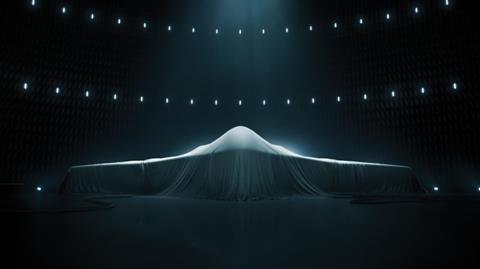The world will soon get a first look at the US military’s next-generation strategic bomber.
Designer Northrop Grumman said on 20 October that it will reveal the company’s B-21 Raider, meant to replace the Northrop B-2 Spirit stealth bomber, on 2 December.

“We’ll unveil the world’s first sixth-generation aircraft,” Northrop says via Twitter. An 11-second video accompanying the tweet shows a rendering of a wide, flat, wing-like fuselage covered by a shroud.
“This changes everything,” white text declares, before fading to black.
The December reveal will take place at Northrop’s facility in Palmdale, California, outside of Los Angeles.
Northrop won the $21.4 billion engineering and design contract for the new strategic bomber in 2015. The company says that it currently has six B-21 airframes in testing and final assembly.
The B-21 programme is one of the Pentagon’s most-secretive weapons development initiatives and very little is known about the design. Renderings released by Northrop show a flying wing design similar to its predecessor, the B-2 Spirit.
Speaking at the Air & Space Forces Association (AFA) conference in Washington DC in September, Northrop vice-president Thomas Jones said that while the B-21 may appear outwardly similar to the B-2, the new type represents a substantial upgrade.
He says the B-21’s real “leap forward” comes from what he calls the aircraft’s “brain” – a computer system using a modular open architecture system which will allow for faster and easier modernisation upgrades over decades of service.
Jones declined to address details regarding the stealthy aircraft’s survivability features. However, he did note that the B-21 was designed to be a “daily flyer” that can be easily maintained.
“We took lessons learned from the B-2… in maintaining stealth platforms,” he said at AFA.
The B-2, which carries a price tag of $2.2 billion per airframe, requires costly and labour-intensive regular maintenance to retain its stealthy surface and low-observable profile.
In addition to the B-21, Northrop is also the prime contractor on a project to replace the second leg of the USA’s so-called “nuclear triad” – the next-generation of intercontinental ballistic missiles known as the Ground Based Strategic Deterrent.


























